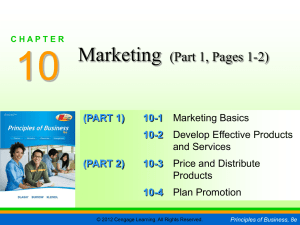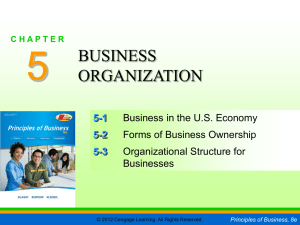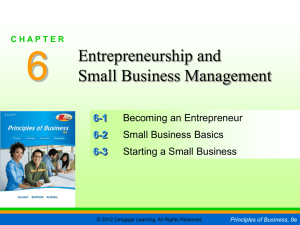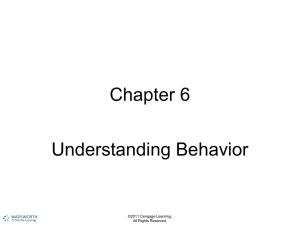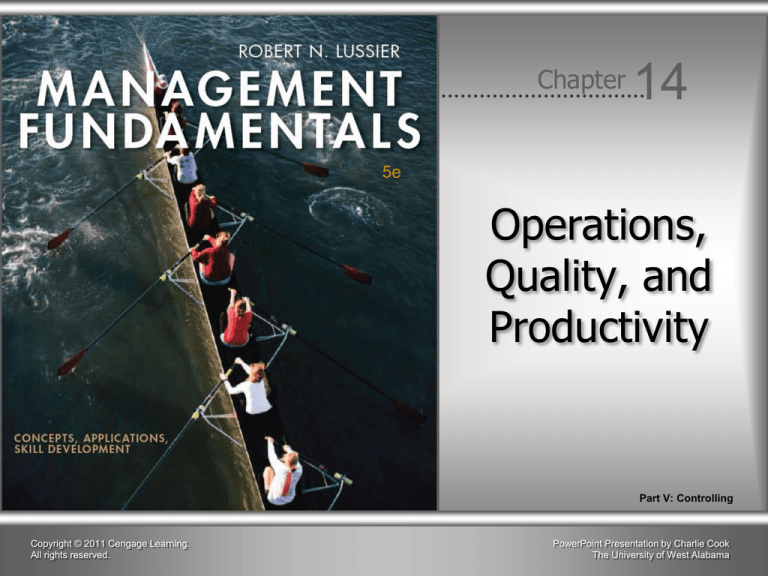
Chapter
14
5e
Operations,
Quality, and
Productivity
Part V: Controlling
Copyright © 2011 Cengage Learning.
All rights reserved.
PowerPoint Presentation by Charlie Cook
The University of West Alabama
Learning Outcomes
After studying this chapter, you should be able to:
1. Describe time-based competition and why it is important.
2. Explain the differences among operations systems with respect to
tangibility of products, levels of customer involvement, operations
flexibility, and management of resources and technology.
3. Discuss what is meant by “quality is a virtue of design.”
4. Explain product, process, cellular, and fixed-position facility
layouts in terms of their level of customer involvement and
flexibility.
5. Describe the similarities and differences among the planning
sheet, Gantt chart, and PERT network.
6. Explain the relationship among inventory control, just-in-time (JIT)
inventory, and materials requirement planning (MRP).
Copyright © 2011 Cengage Learning. All rights reserved.
14–2
Learning Outcomes (cont’d)
After studying this chapter, you should be able to:
7. Explain how statistical process control (SPC) charts and the
exception principle are used in quality control.
8. Describe how to measure productivity and list three ways to
increase it.
9. Define the key terms listed at the end of the chapter.
Copyright © 2011 Cengage Learning. All rights reserved.
14–3
IDEAS ON MANAGEMENT at Frito Lay
1.
How would Frito-Lay’s operations systems be classified?
2.
How would Frito-Lay’s operations systems be described in
terms of design?
3.
How does Frito-Lay manage its operations systems and
supply chain?
4.
How does Frito-Lay control quality?
5.
What are Frito-Lay’s three top-selling products in the United
States, and are its performance and productivity improving?
Copyright © 2011 Cengage Learning. All rights reserved.
14–4
Time-Based Competition and Operations
• Time-Based Competition
The use of strategies to increase the speed with
which an organization goes from creativity to delivery.
Throughput Time: the time an organization takes to
turn a creative idea into an innovation, sell it, and
deliver it.
• Operations
The function concerned with transforming resource
inputs into product outputs.
• Products
A good, a service, or a combination of the two.
Copyright © 2011 Cengage Learning. All rights reserved.
14–5
Exhibit 14–1 ● How Operations Systems Are Classified, Designed, and
Managed
Copyright © 2011 Cengage Learning. All rights reserved.
14–6
Classifying Operations Systems
• Tangibility of Products
Tangible: goods (computers)
Intangible: services (dry cleaning)
Mixed: goods and services (airlines)
Copyright © 2011 Cengage Learning. All rights reserved.
14–7
Classifying Operations Systems (cont’d)
• Level of Customer Involvement
Make-to-stock (MTS)
Producing products with a common design and price in
anticipation of demand; low customer involvement.
Assemble-to-order (ATO)
Producing a standard product with some customized
features; moderate customer involvement.
Make-to-order (MTO)
Producing products after receipt of an order from a specific
customer; high customer involvement.
Copyright © 2011 Cengage Learning. All rights reserved.
14–8
Copyright © 2011 Cengage Learning. All rights reserved.
14–9
Flexibility
• Operations Flexibility
The amount of variety in the products an operation
produces, which determines whether the products are
produced continuously, repetitively, in batches, or
individually in different volumes (amounts) and
varieties (types).
Continuous process operations (CPO)
Produce outputs that are not in discrete units.
Repetitive process operations (RPO)
Produce outputs in an assembly-line-type structure.
Batch process operations (BPO)
Produce different outputs with the same resources.
Copyright © 2011 Cengage Learning. All rights reserved.
14–10
Flexibility (cont’d)
• Operations Flexibility (cont’d)
Individual process operations (IPO)
Produce output to customer specifications.
Project process operations (PPO)
Produce low-volume/high-variety outputs
that take a relatively long time to complete.
Copyright © 2011 Cengage Learning. All rights reserved.
14–11
Copyright © 2011 Cengage Learning. All rights reserved.
14–12
Managing Manufacturing Technology
• Automation
Using machines to perform work
• Computer-Assisted Manufacturing
Computer-aided design (CAD)
Computer-aided manufacturing (CAM)
Computer-integrated manufacturing (CIM)
Copyright © 2011 Cengage Learning. All rights reserved.
14–13
Exhibit 14–2 ● Classifying Operating Systems
Copyright © 2011 Cengage Learning. All rights reserved.
14–14
Designing Operations Systems
• Product Mix
The number of product lines, the number of products
in each line, and the mixture of goods and services
within each line.
• Product Design
New or improved product development.
• Quality As a Virtue of Design
Products designed with cross-functional team input
have fewer operations (manufacturing) problems.
Copyright © 2011 Cengage Learning. All rights reserved.
14–15
Exhibit 14–3 ● Throughput Stages
Copyright © 2011 Cengage Learning. All rights reserved.
14–16
Facility Layout
• Facilities
The physical resources used in the operations
process (e.g., machines, furniture, etc.).
• Facility Layout
The spatial arrangement of physical resources
relative to each other by:
Product layout
Process layout
Cellular layout
Fixed-position layout
Copyright © 2011 Cengage Learning. All rights reserved.
14–17
Exhibit 14–4 ● Facility Layout
Copyright © 2011 Cengage Learning. All rights reserved.
14–18
Exhibit 14–4 ● Facility Layout (cont’d)
Copyright © 2011 Cengage Learning. All rights reserved.
14–19
Copyright © 2011 Cengage Learning. All rights reserved.
14–20
Facility Location
• Location
The physical geographic site of facilities
• Location Factors
Cost
Proximity to Inputs, Customers, and/or Competitors
Transportation
Access to Human Resources
Number of Facilities
Copyright © 2011 Cengage Learning. All rights reserved.
14–21
Join the Discussion
Ethics & Social Responsibility
• Factory Conditions
1. Is it ethical and socially responsible for Gap to
revoke contracts, causing poor workers to lose their
jobs?
2. Is it ethical and socially responsible to Gap’s
stockholders to pay higher labor costs than
necessary, thus reducing profits and their dividends?
Copyright © 2011 Cengage Learning. All rights reserved.
14–22
Capacity Planning
• Capacity
The amount of products an organization can produce
within a given time period (daily, weekly, monthly,
annually).
Copyright © 2011 Cengage Learning. All rights reserved.
14–23
Join the Discussion
Ethics & Social Responsibility
• Oil Reserves
1. Do you think Shell made an honest mistake,
or did it intentionally overstate its reserves?
2. What implications does this overstatement
have for Shell’s capacity planning?
Copyright © 2011 Cengage Learning. All rights reserved.
14–24
Managing Operations Systems
and the Supply Chain
• Planning Schedules and Project Management
Scheduling
Routing
Priority Scheduling
First come-first served
Earliest due date
Shortest operating time
Combination
Copyright © 2011 Cengage Learning. All rights reserved.
14–25
Managing Operations Systems
• Planning Sheet
State an objective and list the sequence of activities
required to meet the objective, when each activity will
begin and end, and who will complete each activity.
• Gantt Chart
Uses bars to illustrate a schedule and progress
toward the objective over a period of time.
Is useful as both a planning and a control tool.
• Performance Evaluation and Review Technique
PERT–a network schedule that illustrates the
dependence of activities.
Copyright © 2011 Cengage Learning. All rights reserved.
14–26
Exhibit 14–5 ● Planning Sheet
Copyright © 2011 Cengage Learning. All rights reserved.
14–27
Exhibit 14–6 ● Gantt Chart (Orders by Week)
* Indicates today’s date—the first day of the third week of May.
Ends of bars indicate scheduled starting and ending dates of project. The shaded part of the bar
indicates the part of the project completed to date, while the blank space to the end of the bar
indicates work still to be completed. The GE project is done. The IBM project is right on schedule
and should be completed this week. The GM project is behind schedule and should be completed
during the fourth week in May. The AT&T project is ahead of schedule and should be completed
during the first week of June.
Copyright © 2011 Cengage Learning. All rights reserved.
14–28
Developing a PERT Network
1. List all the activities/events that must be
completed to reach the specific objective.
2. Determine the time it will take to complete
each activity/event.
3. Arrange the tasks on the diagram in the
sequence in which they must be completed.
4. Determine the critical path.
Copyright © 2011 Cengage Learning. All rights reserved.
14–29
Exhibit 14–7 ● PERT Network
Copyright © 2011 Cengage Learning. All rights reserved.
14–30
Copyright © 2011 Cengage Learning. All rights reserved.
14–31
Exhibit 14–8 ● Inventory Control within the Systems Process
Just-in-Time Inventory:
An inventory control method in which
necessary parts and raw materials are
delivered shortly before they are needed.
Copyright © 2011 Cengage Learning. All rights reserved.
14–32
Materials Requirements Planning
• Materials Requirements Planning (MRP)
A system that integrates operations and inventory
control with complex ordering and scheduling.
• Enterprise Resource Planning (ERP)
Collects, processes, and provides information about a
firm’s entire enterprise.
Copyright © 2011 Cengage Learning. All rights reserved.
14–33
Materials Requirements Planning (cont’d)
• Economic Order Quantity (EOQ)
The optimal quantity of a product to order, determined
on the basis of a mathematical model.
• EOQ example:
Copyright © 2011 Cengage Learning. All rights reserved.
14–34
Supply Chain Management
• Supply Chain Management
The process of coordinating all activities involved in
producing a product and delivering it to the customer.
To provide high-quality products at lowest cost:
Forecast demand for a product
Plan and manage supply and demand
Acquire materials (inputs)
Schedule and produce the product
Warehouse
Control inventory
Distribute the product
Deliver the product
Customer service
Copyright © 2011 Cengage Learning. All rights reserved.
14–35
Inventory Control Technology
• Radio-Frequency Identification (RFID) Tags
An object that can be stuck on or incorporated into a
product, animal, or person for the purpose of
identification using radiowaves.
• Benefits of RFID
Improved efficiency of inventory
tracking and management:
Reduction of labor costs
Simplification of business processes
Reduction of inventory inaccuracies
Copyright © 2011 Cengage Learning. All rights reserved.
~–36
Supply Chain Performance
Information
Operations
Inventory
Supply Chain
Performance
(Responsiveness
and Efficiency)
Transportation
Copyright © 2011 Cengage Learning. All rights reserved.
14–37
Quality Control
• Quality Control
The process of ensuring that all four types of
inventory meet standards.
• Quality Assurance
Means “building in” quality; not attempting to “inspect
it in.”
• International Standards Organization (ISO)
Certifies organizations that meet set quality standards
(ISO9000).
• Six Sigma
Higher levels of quality at lower costs.
Copyright © 2011 Cengage Learning. All rights reserved.
14–38
Total Quality Management (TQM)
• TQM principles
1. Focus on delivering customer value
2. Continually improve systems and processes
3. Focus on managing processes rather than people
4. Use teams to continually improve
• TQM vs. Quality Control
TQM is broader in organizational scope.
Quality is determined by customers’ acceptance, not
by internally-set standards.
Focus is on continuous improvement
Copyright © 2011 Cengage Learning. All rights reserved.
14–39
Exhibit 14–9 ● Five Rules of Customer Human Relations
Copyright © 2011 Cengage Learning. All rights reserved.
14–40
Join the Discussion
Ethics & Social Responsibility
• Social Accountability International
1. Should global multinationals eliminate sweatshops
by having SA8000-certified facilities?
2. Should global multinationals require all their
suppliers to get SA8000 certification?
3. How might working toward SA8000 certification
affect cost, revenues, and profits?
Copyright © 2011 Cengage Learning. All rights reserved.
14–41
Statistical Quality Control
• Statistical Quality Control (SPC)
A process control method that uses statistical tests of
probability in determining if product quality is within
the acceptable range.
Copyright © 2011 Cengage Learning. All rights reserved.
14–42
Statistical Quality Control Steps
1. Set a range that includes the highest and lowest
levels of acceptable quality, with the desired
standard in the middle.
2. Determine the sampling technique and the
frequency of measuring performance.
3. Measure performance and plot it on an SPC
chart.
4. Use the exception principle and do nothing if
performance is within range, but take action if it
is out of control limits.
Copyright © 2011 Cengage Learning. All rights reserved.
14–43
Exhibit 14–10 ● Statistical Process Control Chart for 16-Ounce Bags
of Lay’s Potato Chips
Trend
Copyright © 2011 Cengage Learning. All rights reserved.
14–44
Contributions By Quality Gurus
• Walter Shewhart
Introduced concurrent
controls in manufacturing
• W. Edwards Deming
Linked improved quality to
improved productivity
Deming Prize
• Joseph M. Juran
Developed the Pareto
principle (80/20 rule)
• Armand V. Feigenbaum
Advocated TQM to cut
costs and improve quality
• Philip B. Crosby
“Quality is free” versus the
costs of poor quality
• Genichi Taguchi
Advocated designing
quality into each product
• Steven Kerr
“You get what you reward”
Copyright © 2011 Cengage Learning. All rights reserved.
14–45
Productivity
• Productivity
A performance measure relating outputs to inputs.
Units produced, labor hours per unit, number of workers,
cost of labor, cost of material, machine hours, etc.
• Measuring Productivity
1. Select a base period of time.
2. Determine outputs for time period.
3. Determine cost of inputs.
4. Divide the number of outputs by the inputs to
determine the productivity rate.
Copyright © 2011 Cengage Learning. All rights reserved.
14–46
Productivity (cont’d)
• Production versus Productivity
It is possible to increase production but decrease
productivity.
It is important to calculate productivity rather than just
production output. If you measure only output
production and it increases you can be fooled into
thinking you are doing a better job when in reality you
are doing a worse job.
Copyright © 2011 Cengage Learning. All rights reserved.
14–47
Productivity (cont’d)
• Calculating Productivity Percentage Change
Determine productivity rate for the base period.
Determine productivity rate for the current period.
Subtract the base rate from the current rate.
If the difference is positive, productivity has increased; if
negative, productivity has decreased.
Divide the difference by the current rate to calculate
the percentage of change.
Copyright © 2011 Cengage Learning. All rights reserved.
14–48
Copyright © 2011 Cengage Learning. All rights reserved.
14–49
Productivity (cont’d)
• Ways to Increase Productivity:
Increase the value of the outputs but maintain the
value of the inputs
(↑
O ↔ I)
Maintain the value of the outputs but decrease the
value of the inputs
(↔
O ↓ I)
Increase the value of the outputs but decrease the
value of the inputs
(↑
O ↓ I)
Copyright © 2011 Cengage Learning. All rights reserved.
14–50
Exhibit 14–11 ● Functional Area Ratios
Copyright © 2011 Cengage Learning. All rights reserved.
14–51
Exhibit 14–11 ● Functional Area Ratios (cont’d)
Copyright © 2011 Cengage Learning. All rights reserved.
14–52
Copyright © 2011 Cengage Learning. All rights reserved.
14–53
Exhibit 14–12
The Balanced
Scorecard
Copyright © 2011 Cengage Learning. All rights reserved.
14–54
Exhibit 14–13 ● Futura Industries’ Balanced Scorecard
Copyright © 2011 Cengage Learning. All rights reserved.
14–55
KEY TERMS
•
•
•
•
•
•
•
•
•
•
•
•
balanced scorecard (BSC)
capacity
critical path
customer involvement
facility layout
Gantt chart
International Standards
Organization (ISO)
inventory
inventory control
just-in-time (JIT) inventory
materials requirement
planning (MRP)
operations
Copyright © 2011 Cengage Learning. All rights reserved.
•
•
•
•
•
•
•
•
•
operations flexibility
PERT
planning sheet
priority scheduling
product
productivity
quality control
routing
statistical process control
(SPC)
• supply chain
management
• technology
• time-based competition
14–56


